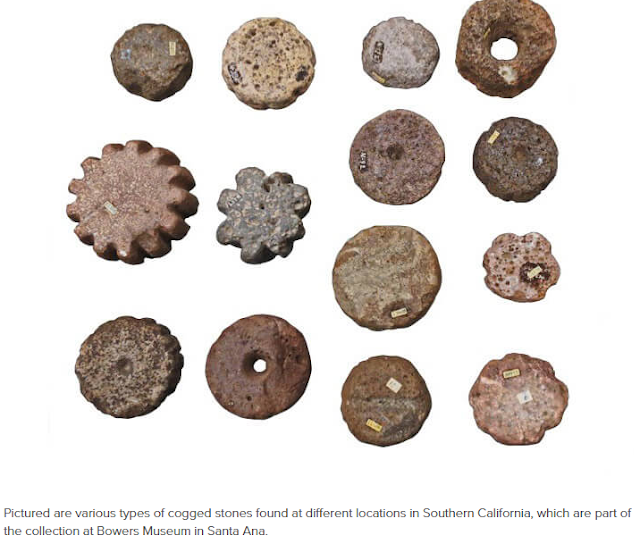Written by the TreasureGuide for the exclusive use of the Treasure Beaches Report.
 |
| Variety of Small Raw Gem Stones. |
Above are some small gem stones. On the far left (partially shown) is an emerald that was found on the Treasure Coast.
Next to that is what I believe is a pyrope garnet. Most of the others shown above are rubies.
Rubies and sapphires are corundum, and glow under a black light. Corundum is aluminum oxide.
Ultraviolet light can be used to find some gem stones. And it can be used as a diagnostic tool.
 |
| Variety of Small Raw Gem Stones. |
You can see the same gem stones under a black light above. The rubies are the ones glowing. The emerald does not glow.
Jewelers actually use both short wave and long wave ultraviolet light for diagnostic purposes, I only have a cheap light that might be used for viewing posters or something like that. Still, it is helpful.
Recently I mentioned that an arrowhead that was found on the Treasure Coast was probably agatized coral. Here is a view under a microscope that shows the coral markings.
 |
| Magnified View of Part of an Agatized Coral Arrowhead. |
I also recently mentioned and showed a few discoidals. Below is a nicely rounded shell that could be a discoidal. It appears to have been nicely shaped into a near perfect circle. It was found on a Treasure Coasst beach.
 |
| Shaped and Rounded Shell That Appears To Be A Discoidal. |
Here is another look at the same rounded piece of shell.
 |
| Edge of Possible Discoidal. |
And below is one that appears to be made of stone. Unlike the one above, it has a concave front and back surfaces. It was found in a Treasure Coast shell pile.
 |
| Treasure Coast Found Discoidal. |
 |
| Another View of the Same Discoidal. |
The unc.edu site says, "Discoidals are game stones and are also referred to as chunky stones. These stones were important in the American Indian game called Chungke. Accounts of the game vary depending on the region, but generally the stone would be rolled on its rim down a prepared smooth surface. One person attempted to hit the rolling stone with a spear, while the other person (who had rolled the stone) attempted to block their opponent’s pole with their own spear. Points were gained by either hitting the stone or blocking the opponent from hitting the stone"
Here is that link for more information.Stone Objects | Ancient North Carolinians (unc.edu)
I've long been skeptical of that definition. While I don't doubt that some were Chungke game, I think that some items that have been identified as discoidals could be something else.
Discoidals seem to vary in a lot of ways. They vary a lot in size and dimensions. They are made of various materials, including stone, shell and pottery. And some seem much better made than others, and some more have what appear to be decorative features.
Below are some examples that are very similar to the one shown immediately above.
Source: Unique Early Discoidal.indd (pcas.org)
Here is link to another reference that shows some more decorative disoidals.
A Series of Discoidals from Northern San Diego County, California (escholarship.org)
Discoidals have been reported found in association with cogged stones, which have an edge that is "cogged" rather than smooth and round. You can see some of those below.
 |
| Source: See CSUF link below. |
Some of those look like what I might call cogged stones, but some are plain discs. And some look like beads or ornaments to me. Some may be incomplete. I have a hard time classifying all those as the same thing.
Here is a paragraph from the same source...
While how cogged stones were used by early Native Americans is unknown, in their paper, the CSUF researchers noted that since the stones were first discovered in the 1950s, more than 40 possible uses have been suggested for these artifacts by archaeologists. Hypothesized uses in previous studies include use as fishing weights, for the manufacture of fishing lines or rope, toys, game pieces, throwing weapons or killing stones. Alternative hypotheses proposed include their use as sacred burial, mortuary and ceremonial objects.And here is that link.
In my uninformed opinion, discoidals could have the same variety of uses.
I've been posting a variety of different kinds of objects that can be found on the Treasure Coast. I hope that increases your awareness of the different kinds of objects that can be found on beaches and helps you identify them when you see them.
---
 |
| Source: MagicSeaWeed.com |
So the predicted surf for Monday for Monday has increased, and is now up to 8 - 12 feet. If we actually get that, it could get up an into the dunes, depending upon some other factors, of course. I wouldn't, however, be surprised if the prediction gets smaller in the next few days. That happens a lot of the time.
Notice the change in wind direction right before the peak big increase. You'll see that more often than not.
The tides are a little bigger today. Easter occurs on the first Sunday after the first full moon after the Spring equinox.
I'm eager to see a nice low tide.
Keep watching the surf predictions.
---
---
Good hunting,
Treasureguide@comcast.net
